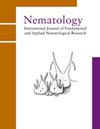Unveiling two novel Ditylenchus (Nematoda: Anguinidae) species inhabiting the growing medium of Rhododendron simsii imported from Japan
IF 1.2
4区 生物学
Q2 ZOOLOGY
引用次数: 0
Abstract
The present study describes two new Ditylenchus species, isolated from the growing medium of Rhododendron simsii imported from Japan, at the Ningbo plant quarantine laboratory, Ningbo, P.R. China. Ditylenchus parvicauda n. sp. is an amphimictic species. Females have six incisures in the lateral fields, a medium length slim body, a short delicate stylet with asymmetrical stylet knobs, the secretory-excretory (S-E) pore located posterior to the isthmus and in the anterior region of the basal pharyngeal bulb, a posteriorly located vulva (V = 80.9-83.0), post-uterine sac (PUS) tube-like, and the tail cylindrical, tapering gradually towards finely rounded terminus. Males are similar to females in general morphology and have 10.1-14.9 μm long spicules. The second new species, D. gracicauda n. sp. is characterised by having a long and slender body, the presence of a vulval flap, four lines in the lateral field, a narrow and low lip region not offset, the S-E pore located posterior to the isthmus but not in the anterior region of the basal pharyngeal bulb, a posteriorly located vulva (V = 71.1-76.2), a short post-vulval uterine sac short (4.5-9.2 μm), and the tail slender, tapering gradually towards finely rounded to wedge-shaped terminus. The two new species were also characterised molecularly using 18S, ITS and the D2-D3 expansion segments of 28S rRNA genes. Our phylogenetic analyses showed their independent place among available Ditylenchus species. Several Ditylenchus species are regulated pests, and the introduction of these species into a new environment may result in diseases among native plants or vegetation in the area. Therefore, careful attention must be directed towards newly discovered species, particularly those under quarantine observation.揭示栖息于日本进口杜鹃花生长介质中的两个新的根瘤蚤(线虫纲:鳗鲡科)物种
本研究描述了在中国宁波植物检疫实验室从日本进口的杜鹃花生长介质中分离到的两个新的Ditylenchus物种。Ditylenchus parvicauda n. sp.为两栖种。雌虫体侧有 6 个切口,体长中等偏细,花柱短而纤细,有不对称的花柱钮,分泌孔位于咽峡后部和基部咽球前部,外阴位于后部(V = 80.9-83.0),子宫后囊(PUS)管状,尾圆柱形,向细圆末端逐渐变细。雄虫的总体形态与雌虫相似,有 10.1-14.9 μm 长的小刺。第二个新种 D. gracicauda n. sp.的特征是身体细长,有外阴瓣,外侧领域有四条线,唇区狭窄而低,没有偏移,S-E 孔位于咽峡后部,但不在基部咽球的前部区域,外阴位于后部(V = 71.外阴位于后部(V = 71.1-76.2),外阴后的子宫囊较短(4.5-9.2 μm),尾部细长,向细圆至楔形末端逐渐变细。我们还利用 18S、ITS 和 28S rRNA 基因的 D2-D3 扩增片段对这两个新物种进行了分子鉴定。我们的系统进化分析表明,它们在现有的 Ditylenchus 物种中具有独立的地位。有几个 Ditylenchus 物种是受管制的害虫,将这些物种引入新环境可能会导致该地区的本地植物或植被发生病害。因此,必须对新发现的物种,尤其是正在接受检疫观察的物种给予仔细关注。
本文章由计算机程序翻译,如有差异,请以英文原文为准。
求助全文
约1分钟内获得全文
求助全文
来源期刊

Nematology
生物-动物学
CiteScore
2.60
自引率
33.30%
发文量
67
审稿时长
3 months
期刊介绍:
Nematology is an international journal for the publication of all aspects of nematological research (with the exception of vertebrate parasitology), from molecular biology to field studies. Papers on nematode parasites of arthropods, and on soil free-living nematodes, and on interactions of these and other organisms, are particularly welcome. Research on fresh water and marine nematodes is also considered when the observations are of more general interest.
Nematology publishes full research papers, short communications, Forum articles (which permit an author to express a view on current or fundamental subjects), perspectives on nematology, and reviews of books and other media.
 求助内容:
求助内容: 应助结果提醒方式:
应助结果提醒方式:


